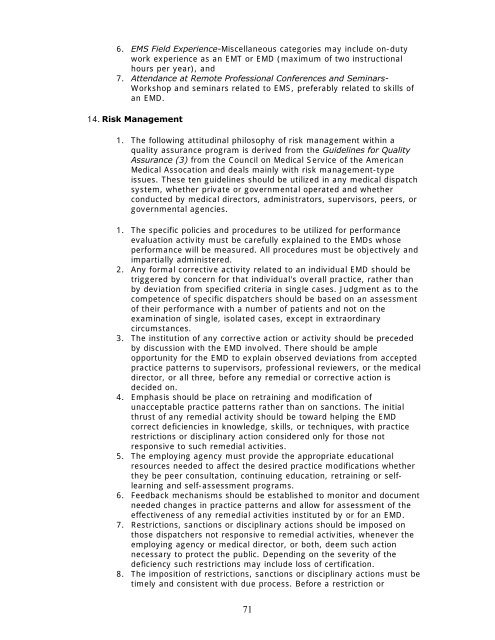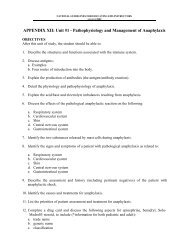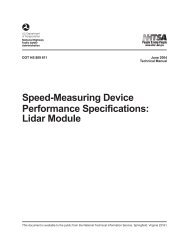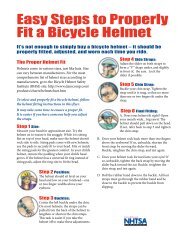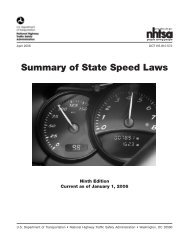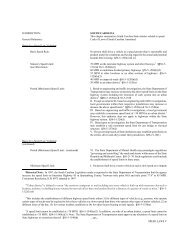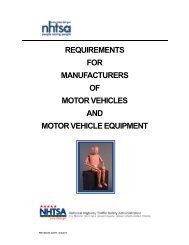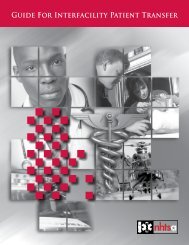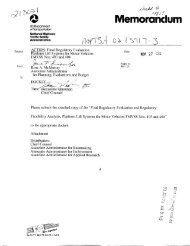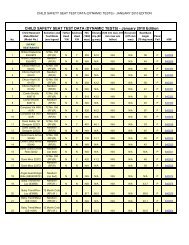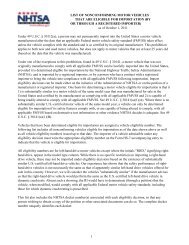Standard Practice for Emergency Medical Dispatch ... - NHTSA
Standard Practice for Emergency Medical Dispatch ... - NHTSA
Standard Practice for Emergency Medical Dispatch ... - NHTSA
Create successful ePaper yourself
Turn your PDF publications into a flip-book with our unique Google optimized e-Paper software.
6. EMS Field Experience-Miscellaneous categories may include on-duty<br />
work experience as an EMT or EMD (maximum of two instructional<br />
hours per year), and<br />
7. Attendance at Remote Professional Conferences and Seminars-<br />
Workshop and seminars related to EMS, preferably related to skills of<br />
an EMD.<br />
14. Risk Management<br />
1. The following attitudinal philosophy of risk management within a<br />
quality assurance program is derived from the Guidelines <strong>for</strong> Quality<br />
Assurance (3) from the Council on <strong>Medical</strong> Service of the American<br />
<strong>Medical</strong> Assocation and deals mainly with risk management-type<br />
issues. These ten guidelines should be utilized in any medical dispatch<br />
system, whether private or governmental operated and whether<br />
conducted by medical directors, administrators, supervisors, peers, or<br />
governmental agencies.<br />
1. The specific policies and procedures to be utilized <strong>for</strong> per<strong>for</strong>mance<br />
evaluation activity must be carefully explained to the EMDs whose<br />
per<strong>for</strong>mance will be measured. All procedures must be objectively and<br />
impartially administered.<br />
2. Any <strong>for</strong>mal corrective activity related to an individual EMD should be<br />
triggered by concern <strong>for</strong> that individual's overall practice, rather than<br />
by deviation from specified criteria in single cases. Judgment as to the<br />
competence of specific dispatchers should be based on an assessment<br />
of their per<strong>for</strong>mance with a number of patients and not on the<br />
examination of single, isolated cases, except in extraordinary<br />
circumstances.<br />
3. The institution of any corrective action or activity should be preceded<br />
by discussion with the EMD involved. There should be ample<br />
opportunity <strong>for</strong> the EMD to explain observed deviations from accepted<br />
practice patterns to supervisors, professional reviewers, or the medical<br />
director, or all three, be<strong>for</strong>e any remedial or corrective action is<br />
decided on.<br />
4. Emphasis should be place on retraining and modification of<br />
unacceptable practice patterns rather than on sanctions. The initial<br />
thrust of any remedial activity should be toward helping the EMD<br />
correct deficiencies in knowledge, skills, or techniques, with practice<br />
restrictions or disciplinary action considered only <strong>for</strong> those not<br />
responsive to such remedial activities.<br />
5. The employing agency must provide the appropriate educational<br />
resources needed to affect the desired practice modifications whether<br />
they be peer consultation, continuing education, retraining or selflearning<br />
and self-assessment programs.<br />
6. Feedback mechanisms should be established to monitor and document<br />
needed changes in practice patterns and allow <strong>for</strong> assessment of the<br />
effectiveness of any remedial activities instituted by or <strong>for</strong> an EMD.<br />
7. Restrictions, sanctions or disciplinary actions should be imposed on<br />
those dispatchers not responsive to remedial activities, whenever the<br />
employing agency or medical director, or both, deem such action<br />
necessary to protect the public. Depending on the severity of the<br />
deficiency such restrictions may include loss of certification.<br />
8. The imposition of restrictions, sanctions or disciplinary actions must be<br />
timely and consistent with due process. Be<strong>for</strong>e a restriction or<br />
71


